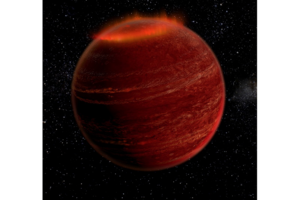Are brown dwarfs stars or planets? Check their auroras.
Researchers have found evidence of auroras, phenomena typically associated with planets, on brown dwarf stars.

An artist's concept of brilliant auroras on the brown dwarf LSR J1835+3259, a misfit failed star about 18.5 light-years from Earth. The auroras are the first ever detected beyond our own solar system.
Chuck Carter and Gregg Hallinan/Caltech
Classifying brown dwarfs is not easy. They are too massive to be planets, and too small to be stars, but at the same time have some characteristics of both.
Now, by observing one of these so-called failed stars, a team led by Gregg Hallinan, an assistant professor of astronomy at the California Institute of Technology in Pasadena, has found a feature that makes brown dwarfs more like super-sized planets.
Professor Hallinan and his team have discovered that a brown dwarf 20 light-years away hosts powerful auroras near their magnetic poles, according to a Caltech report. The researchers published their findings in the July 30 issue of the journal Nature.
“We're finding that brown dwarfs are not like small stars in terms of their magnetic activity; they're like giant planets with hugely powerful auroras,” Hallinan said in the report. "If you were able to stand on the surface of the brown dwarf we observed – something you could never do because of its extremely hot temperatures and crushing surface gravity – you would sometimes be treated to a fantastic light show courtesy of auroras hundreds of thousands of times more powerful than any detected in our solar system.”
Auroras, the radiant displays of colors in the sky known on Earth as the northern or southern lights, are seen on all planets with magnetic fields in the solar system, according to Space.com's Charles Q. Choi. "They are caused by currents in the magnetosphere of a planet — the shell of electrically charged particles captured by a planet's magnetic field — that force electrons to rain down on the atmosphere, colliding with the molecules within and making them give off light," Mr. Choi explains.
In the early 2000s, astronomers found that brown dwarfs emit radio waves, but not in the same way that stars do.
In 2006, Hallinan, back then a graduate student, discovered that brown dwarfs can actually pulse at radio frequencies. That discovery led him to speculate that those radio emissions could be caused by auroras.
Hallinan and his colleagues conducted an extensive observation on a Jupiter-size brown dwarf called LSRJ 1835+3259, using the most powerful radio telescope in the world, as well as optical instruments.
He notes that brown dwarfs offer a convenient stepping stone to studying exoplanets, planets orbiting stars other than our sun. "I'm trying to build a picture of magnetic field strength and topology and the role that magnetic fields play as we go from stars to brown dwarfs and eventually right down into the planetary regime," he says.

